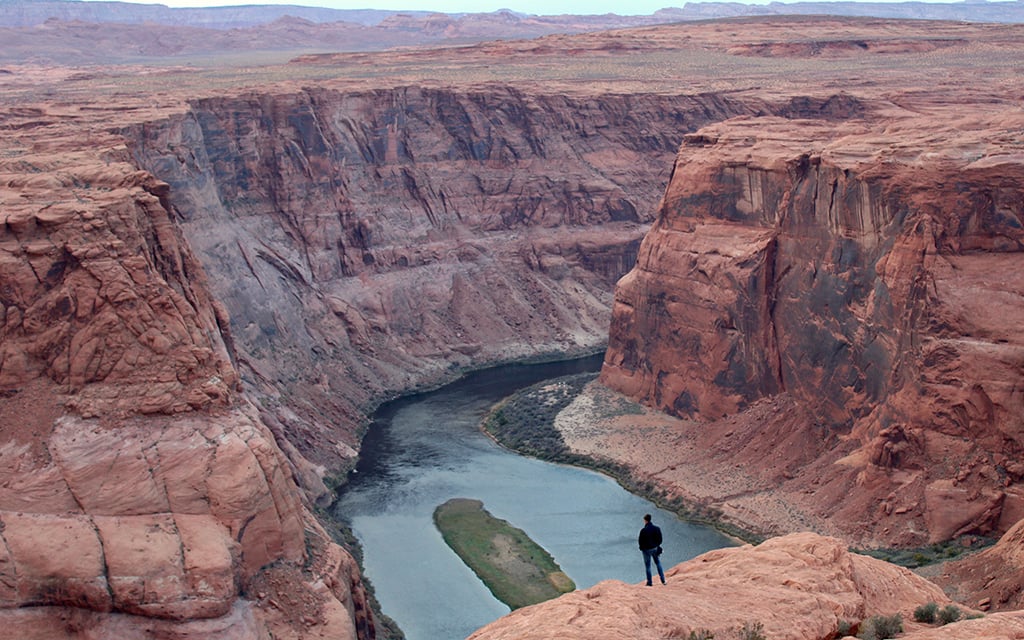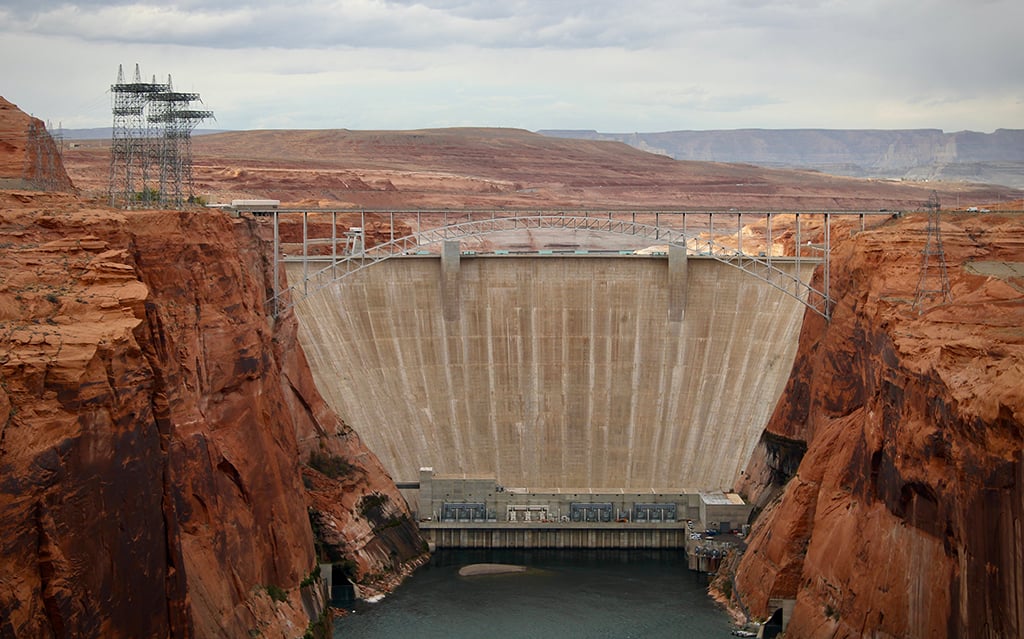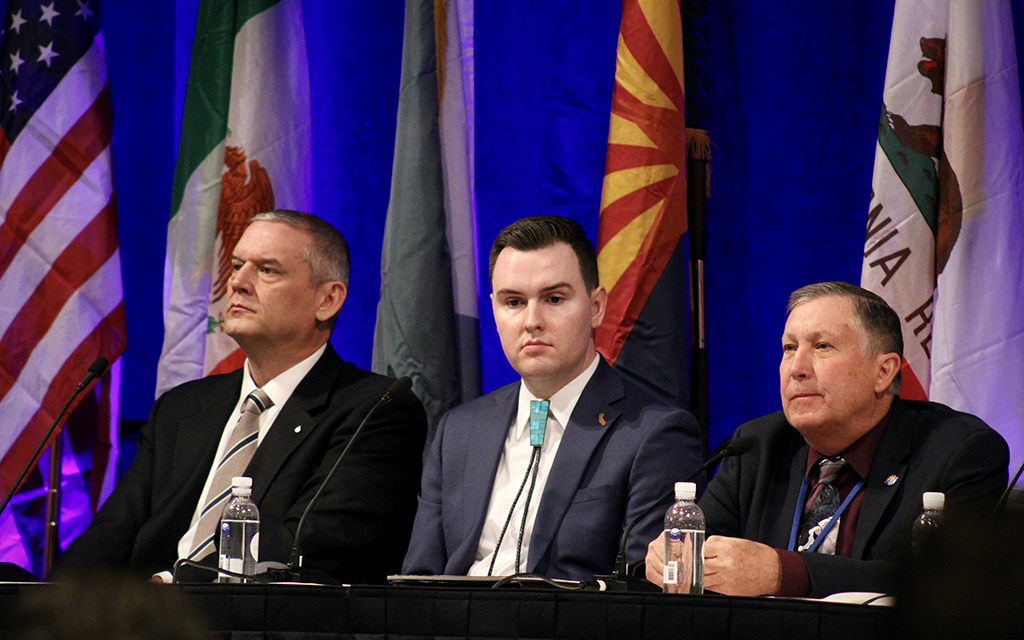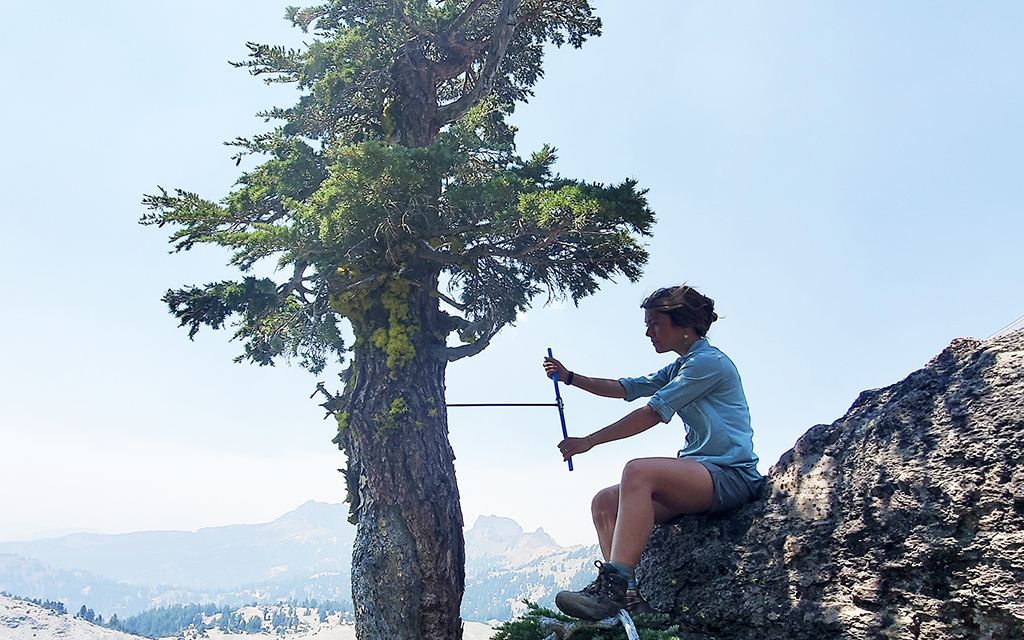
A man looks out over the Colorado River near Page in November 2022. The seven states that manage the river are divided over how to manage the dwindling river, which has been under stress from climate change and an ongoing drought, and how to share its water. (Photo by Alex Hager/KUNC)
The seven states that use water from the Colorado River proposed competing plans to the federal government this week on the river’s future management, with upper and lower basin states offering their own visions.
Arizona joined California and Nevada with a plan that calls for a new framework for measuring the amount of water in western reservoirs and a method for distributing water cutbacks accordingly.
The proposal from the Upper Basin states – Colorado, New Mexico, Utah and Wyoming – puts into writing one of their most-repeated talking points: That they bear the brunt of climate change, which is reducing the amount of snow in the mountains where the Colorado River begins, and any new rules for the river need to reflect that.
“We can no longer accept the status quo of Colorado River operations,” Becky Mitchell, Colorado’s top water negotiator, wrote in a press release. “If we want to protect the system and ensure certainty for the 40 million people who rely on this water source, then we need to address the existing imbalance between supply and demand.
“That means using the best available science to work within reality and the actual conditions of Lake Powell and Lake Mead. We must plan for the river we have – not the river we dream for,” Mitchell wrote.
Neither plan is final. Federal and state officials had targeted mid-March for states to submit plans, with the aim of giving the current administration time to implement any new water rules in case November’s election brings a change of administration.

Glen Canyon Dam holds back Lake Powell, which fell to an all-time low last year as the Colorado River basin continues to struggle through a decades-long drought. (Photo by Alex Hager/KUNC)
It’s the latest turn in a dispute over water management that stretches back more than a century. The current guidelines for sharing the river expire in 2026, and states are trying to agree on new rules, at a time when climate change shrinks the river and increases pressure on states to rein in demand.
The Upper Basin’s “plan for the river we have” calls for a new structure for water releases from Lake Powell, where water levels last year dipped to a new all-time low, about 20% of capacity.
Upper Basin states are currently obligated to send at least 7.5 million acre-feet of water downstream each year, calculated as an average of the previous 10 years of flows from upper to lower basins. The Upper Basin plan suggests releases as low as 6 million acre-feet per year.
That could run afoul of the “Colorado River Compact,” the 1922 agreement that controls river management and says, “The States of the Upper Division will not cause the flow of the river … to be depleted” below a specified level.
But the Upper Basin states suggest they could allow less water to pass downriver because climate change is causing the lower flows, not use by the states themselves. The idea has not yet been tested in court.
Lower Basin leaders call that suggestion impractical.
“Arguing legal interpretations until we’re all blue in the face doesn’t do anything to proactively respond to climate change,” said JB Hamby, California’s top water negotiator.
The Upper Basin states’ proposal also specifically mentions mitigating “dead pool” – when levels drop so low that water can no longer pass through the dam at all.
Efforts to halt falling Colorado River levels have been a core part of river management in recent years. If water levels dip below the intake tubes for hydropower turbines in Glen Canyon Dam, operators would have to shut down electric generators that supply power to about 5 million people across seven states. The next step is dead pool.

From left, John Entsminger, JB Hamby and Tom Buschatzke, the top water negotiators for Nevada, California and Arizona, respectively, on a panel at the Colorado River Water Users Association annual meeting in Las Vegas in December. (Photo by Alex Hager/KUNC)
Reservoir level concerns drove a raft of emergency water releases from other upstream reservoirs and have fueled calls from environmental groups to plan for a future without the Glen Canyon Dam.
The Lower Basin states, meanwhile, have their own plan.
Currently, the elevations of Lake Powell and Lake Mead serve as barometers for the amount of water in the Colorado River system. The Lower Basin states are pushing a “more holistic” approach that would include a handful of other reservoirs in the system, including Blue Mesa in Colorado, Navajo in New Mexico, and Flaming Gorge in Wyoming and Utah.
The Lower Basin plan would not only determine when it’s time to cut back on water allocations to different states, but how big those cutbacks should be. Under current rules, only Lower Basin states face cutbacks during times of shortage. The new plan would hit Lower Basin states first, but Upper Basin states would also see cutbacks if reservoirs dipped below a certain point.
“It’s very easy to craft an alternative that doesn’t require any sacrifice. But that’s not what the Lower Basin alternative does,” Hamby said.
“The Lower Basin is home to three quarters of the Colorado River Basin’s population, most of the basin’s tribes, and some of the most productive farmland in the country,” he said. “Our proposal requires adaptation and sacrifice by water users across the region.”
Some analysts say this week’s proposals, while divergent, may be a necessary first step before negotiators are able to find some agreement.
“We need to think about the whole basin as one interconnected system,” said Elizabeth Koebele, an assistant professor of political science at the University of Nevada, Reno. “I think there are elements of both plans that kind of get at that thought and maybe those are places that we could see come together in a future consensus plan.”
Both Upper Basin and Lower Basin state officials say they are open to more dialogue and have hopes of reaching agreement.
“We look forward to working with our sister Lower Basin states to resolve differences in approach and create a seven-state consensus alternative,” Estevan López, New Mexico’s top water negotiator, wrote in a press release.
Officials with the Bureau of Reclamation, the federal agency that manages Western dams and reservoirs, said they expect to work with states over the spring and summer and have a draft proposal for post-2026 river management by the end of this year.
-This story is part of ongoing coverage of the Colorado River, produced by KUNC and supported by the Walton Family Foundation.
